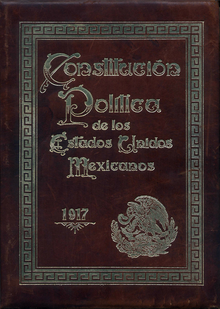This article needs additional citations for verification. (January 2024) |

Sexenio is the popular term for the term of office on the President of Mexico. Under article 83 of the Mexican Constitution, the president is limited to a single six-year term, and no one who holds the office, even on a caretaker basis, is permitted to run for or hold the office ever again.[2] It is one of the country's most important political institutions, because it is one of the few significant limitations on the holder of the Executive power in Mexico, which is strong at local, state, and national levels. The sexenio is a reaction to the failed re-election experiences occurring during the first 50 years as an independent country and, most notably, the Porfiriato era (1876–1911).
Originally known as Sexenal Plan (Plan Sexenal), the main goal of the sexenio was to provide a clear path to follow for governmental actions during a president's term of office, with the intention to fulfill the unsatisfied social and economic demands—mainly those related to agricultural, industrial and urban development and to the improvement of the precarious laboral conditions of workers—which were major root causes of the 1910 revolution.
In addition to the presidency, state governors also face this restriction; no one elected as a governor may ever hold the post again, even on an interim or substitute basis.
- ^ Olachea Colome, Armando (2020-05-02). "Título Tercero. Capítulo III del Poder Ejecutivo. Artículo 83" [Title Three. Chapter III of the Executive Branch. Article 83] (PDF). Suprema Corte de Justicia de la Nación (in Spanish). Archived (PDF) from the original on 2024-07-18. Retrieved 2024-10-25.
- ^ "Political Constitution of the United Mexican States" (PDF). Tribunal Electoral del Poder Judicial de la Federación. p. 30. Retrieved 2024-10-24.